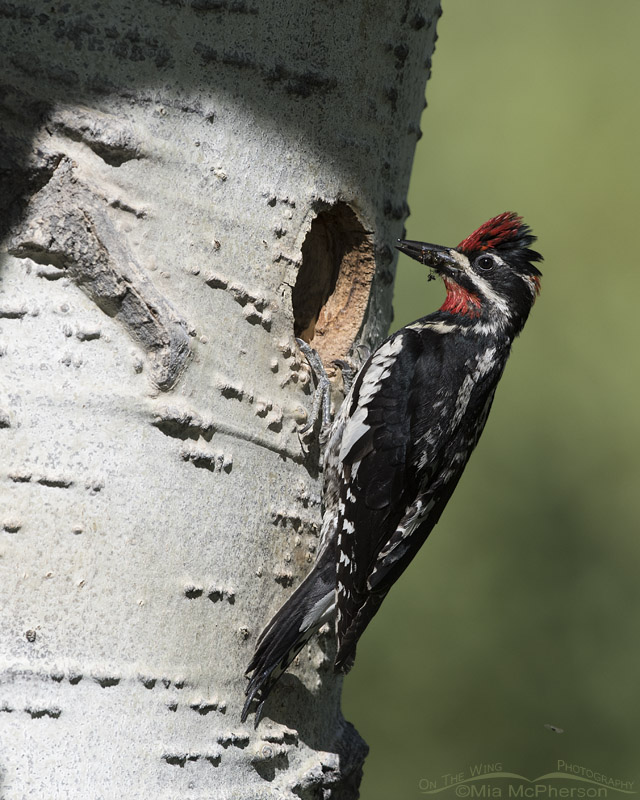 Female Red-naped Sapsucker with food – Nikon D810, f7.1, 1/1600, ISO 400, -0.7 EV, Nikkor 500mm VR, natural light
Female Red-naped Sapsucker with food – Nikon D810, f7.1, 1/1600, ISO 400, -0.7 EV, Nikkor 500mm VR, natural light
Yesterday was predicted to be a scorcher in the Salt Lake Valley so a trip up to the mountains sounded refreshing and cooler. Much cooler than the 103°F it reached later in the day any way! It is so beautiful in the high country this time of the year with some snow left on the highest peaks, the wildflowers in bloom and everything seems so green and lush that even if I don’t find birds to photograph I am happy to explore.
Finding Red-naped Sapsuckers feeding chicks at a nesting cavity in the Uintas made my day! Both the female and male were busy bringing food to the chicks and they brought it quite often.
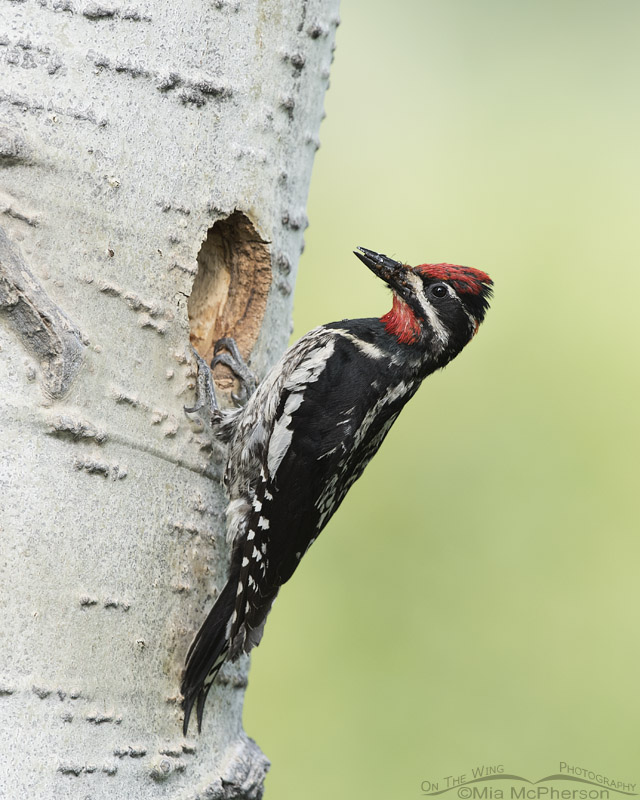 Female Red-naped Sapsucker about to feed chicks – Nikon D810, f7.1, 1/320, ISO 500, Nikkor 500mm VR, natural light
Female Red-naped Sapsucker about to feed chicks – Nikon D810, f7.1, 1/320, ISO 500, Nikkor 500mm VR, natural light
Unlike Williamson’s Sapsuckers who in my experiences call right before they fly to the nesting cavity these Red-naped Sapsuckers did not call right before they get to the nest which made it a bit harder to anticipate their arrival so yesterday I kept my eyes open for their arrival at the nest. I could see that the adults were bringing ants and other insects in their beaks to feed their very noisy young. Unfortunately the chicks did not stick their heads out of the nesting cavity when the adults came in.
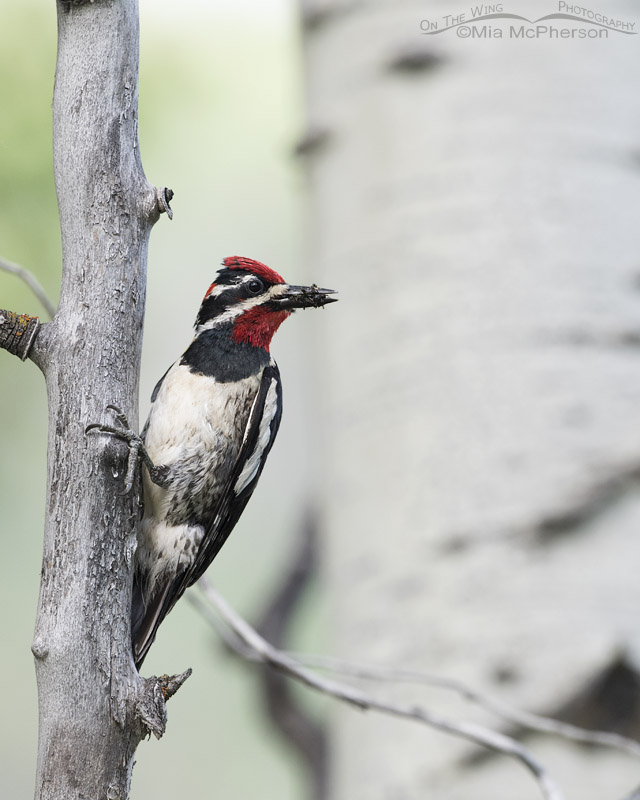 Male Red-naped Sapsucker with a beak full of prey – Nikon D810, f7.1, 1/320, ISO 500, Nikkor 500mm VR, natural light
Male Red-naped Sapsucker with a beak full of prey – Nikon D810, f7.1, 1/320, ISO 500, Nikkor 500mm VR, natural light
Some times the adults would fly directly to the nesting cavity and other times they would fly to a nearby tree before they would fly to the nest. I struggled a bit with the exposure because of shadows, clouds and sun plus the high contrast of the black, red and white sapsuckers against the white bark of the aspens but overall I was pleased with my images.
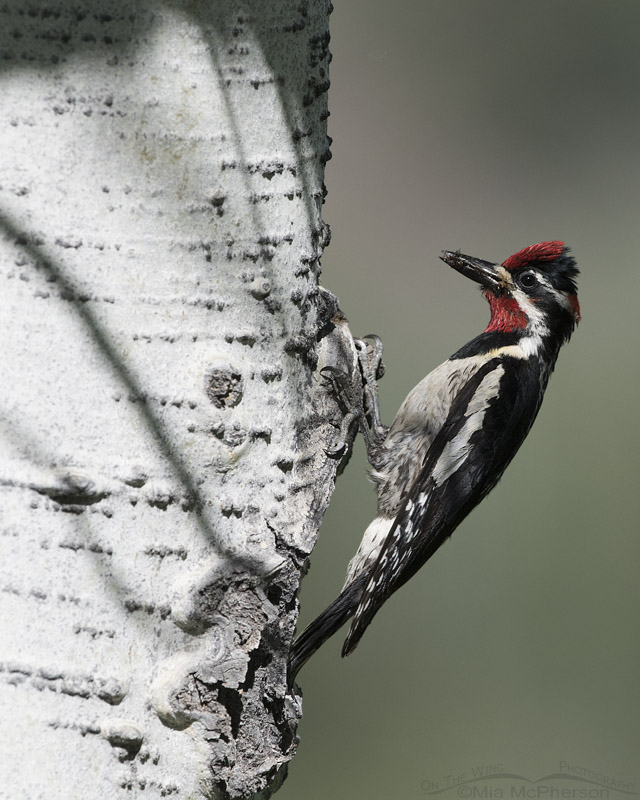 Male Red-naped Sapsucker with prey for chicks – Nikon D810, f7.1, 1/2500, ISO 400, -0.7 EV, Nikkor 500mm VR, natural light
Male Red-naped Sapsucker with prey for chicks – Nikon D810, f7.1, 1/2500, ISO 400, -0.7 EV, Nikkor 500mm VR, natural light
There were times when both adults were at the nesting tree at the same time. in the image above the male was just above the nesting cavity with a beak full of ants waiting for the female to leave before he dropped down to the opening and fed the chicks.
Both adults look very similar but the feature I use to determine the sex of them adults most often is that the females have a little bit of white feathers directly under their bills and the males do not. There are individual females that don’t display the white plumage under the bill. Males usually have redder napes plus a red cheek patch, this male showed very little red in its cheeks.
In the field I tried to determine sex then quickly gave up because the sapsuckers flew in and out so fast that I needed to concentrate on getting the images and I knew I could sex them later at home when I viewed the photographs I took.
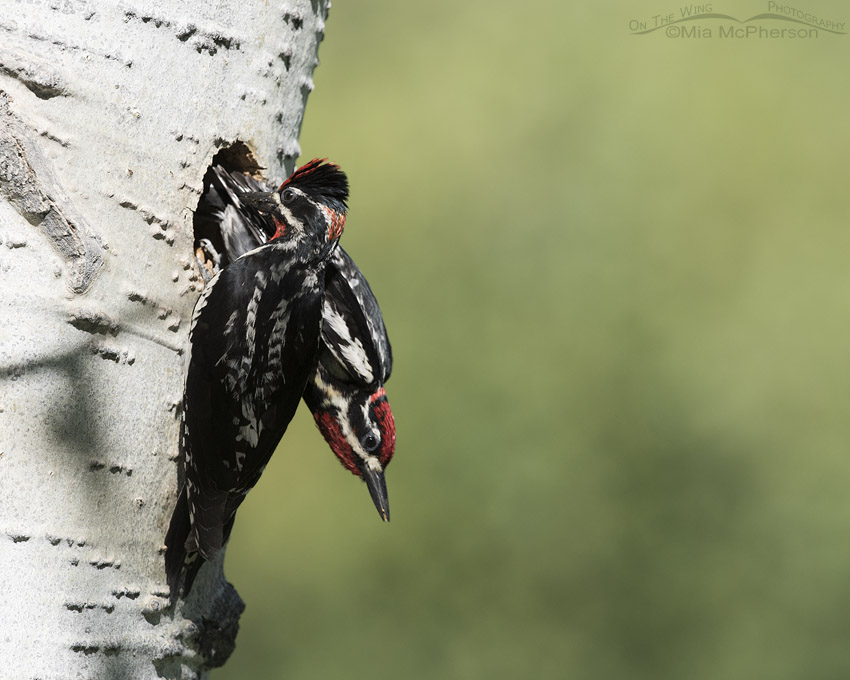 Female and male Red-naped Sapsucker at nest – Nikon D810, f7.1, 1/1250, ISO 400, -0.7 EV, Nikkor 500mm VR, natural light
Female and male Red-naped Sapsucker at nest – Nikon D810, f7.1, 1/1250, ISO 400, -0.7 EV, Nikkor 500mm VR, natural light
I did get a few images with both the female and the male in the frame, in this one the female is at the front with a bill filled with prey and the male is exiting the opening to the nesting cavity. The adults were very busy feeding their young! They have three to seven young and that is a lot of mouths to feed.
All in all it was a wonderful morning in the Uintas and I savored the cooler temps and enjoyed all the birds I saw.
Life is good.
Mia
Click here to see more of my Red-naped Sapsucker photos plus facts and information about this species.


Whoa, love these!!!
Just glorious.
Is that a silver birch they are nesting in?
They are great shots, never seen a red-naped sapsucker and like how their relay keeps the food coming and the nest protected.
What wonderful photos – and what a privilege to see these birds in such exquisite detail at their nest. Thank you!
Great series! Balancing the exposure to keep both the white of the tree and the black of the bird happy must have been a challange. Thanks, John
These are great images! It always amazes me how many fish a Puffin can hold or ants a Sapsucker can hold without dropping the first one or two. I’d think that they’d drop the first one trying to pick up the second, etc.
Gorgeous shots, Mia.
Hi Mia. Wonderful shots. How do you tell adult male from female?
Beautiful pictures of beautiful birds!
I figure it will take a while for you to wipe that smile off your face. Like Ron, you too
nailed the male leaving the nest cavity. Great series Mia, and getting the “exit shot”
of the male leaving, and I know they do that fast, just “adds icing to your cake.”
Well done Mia, very well done. ;-)))